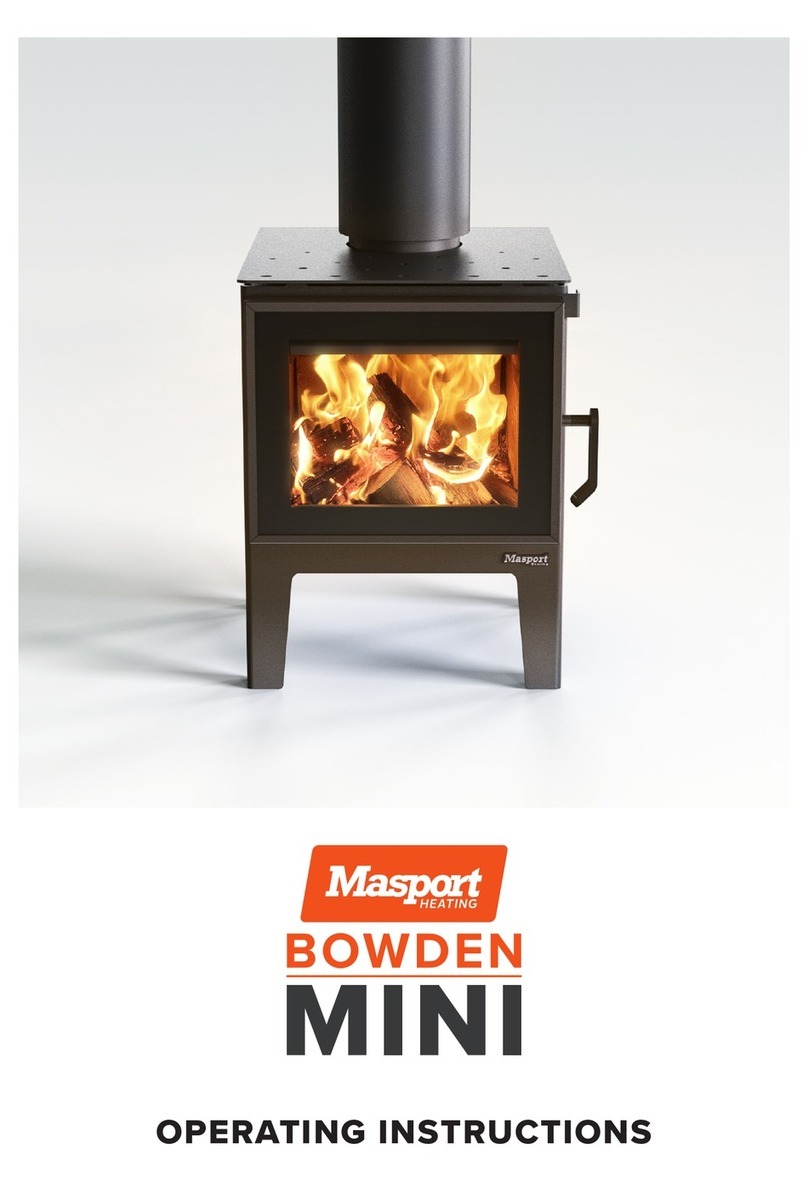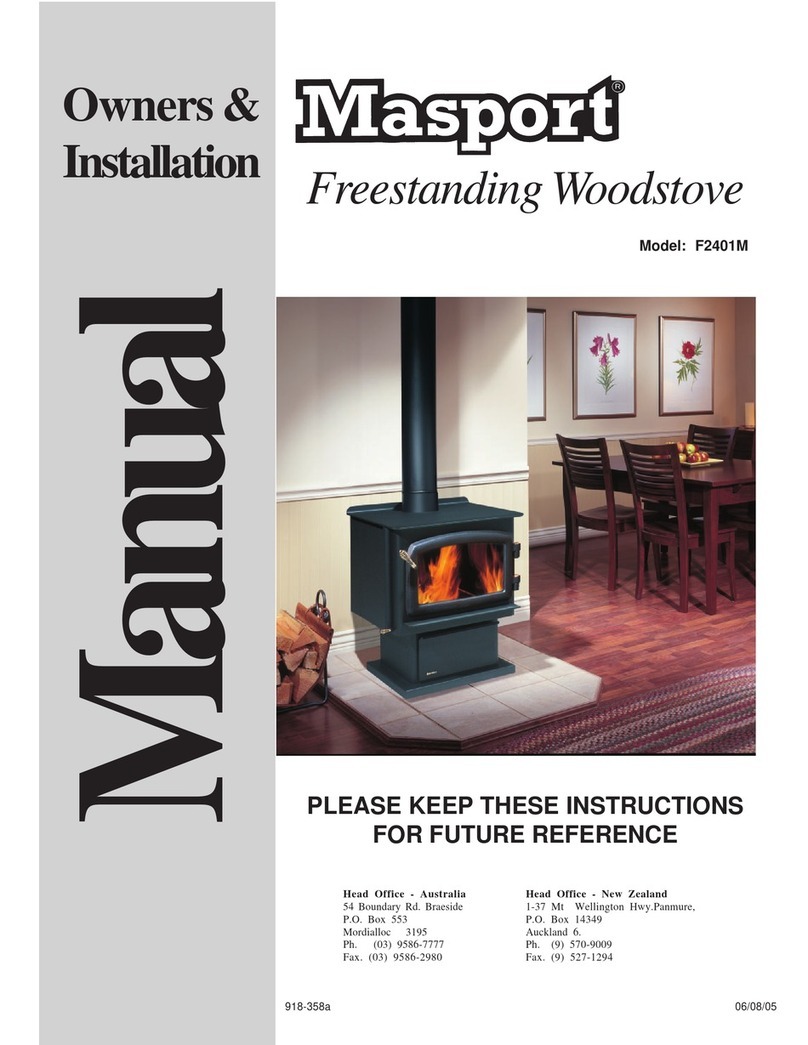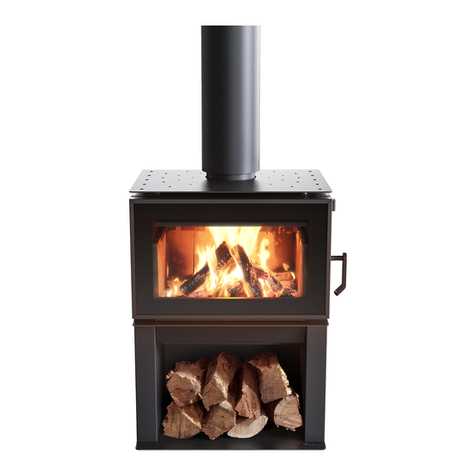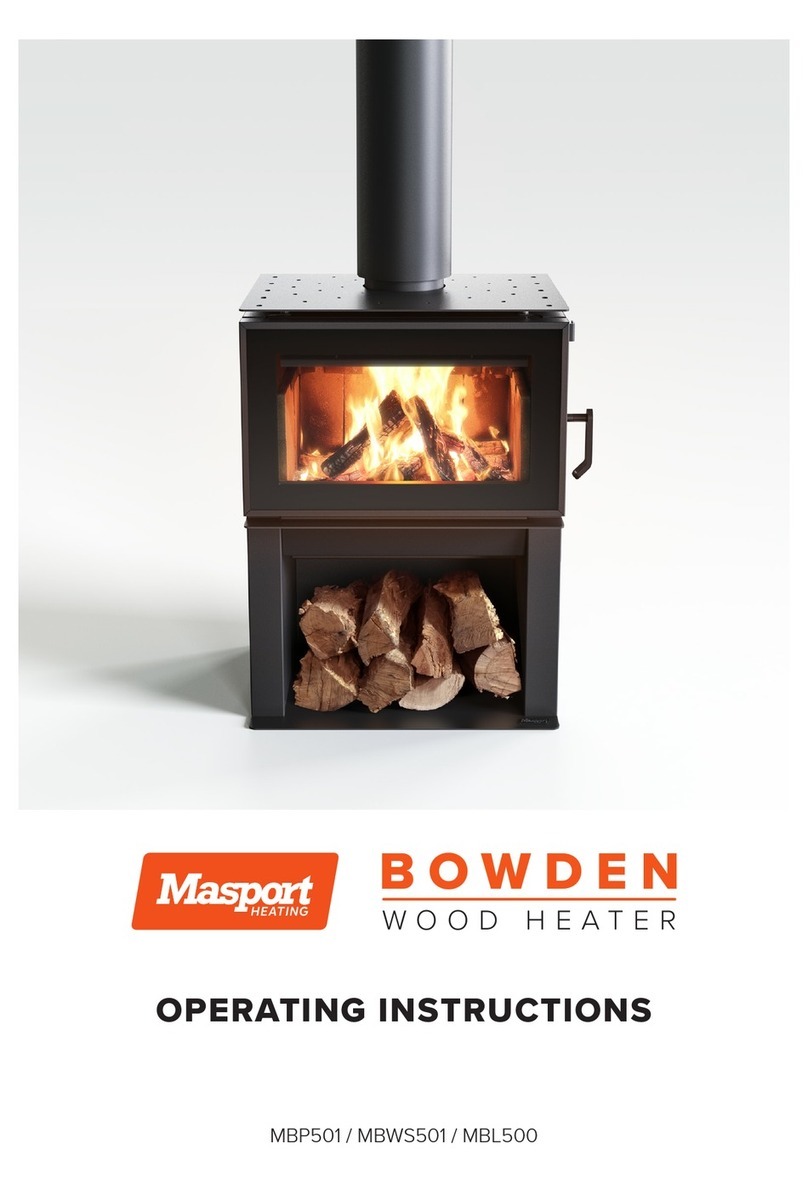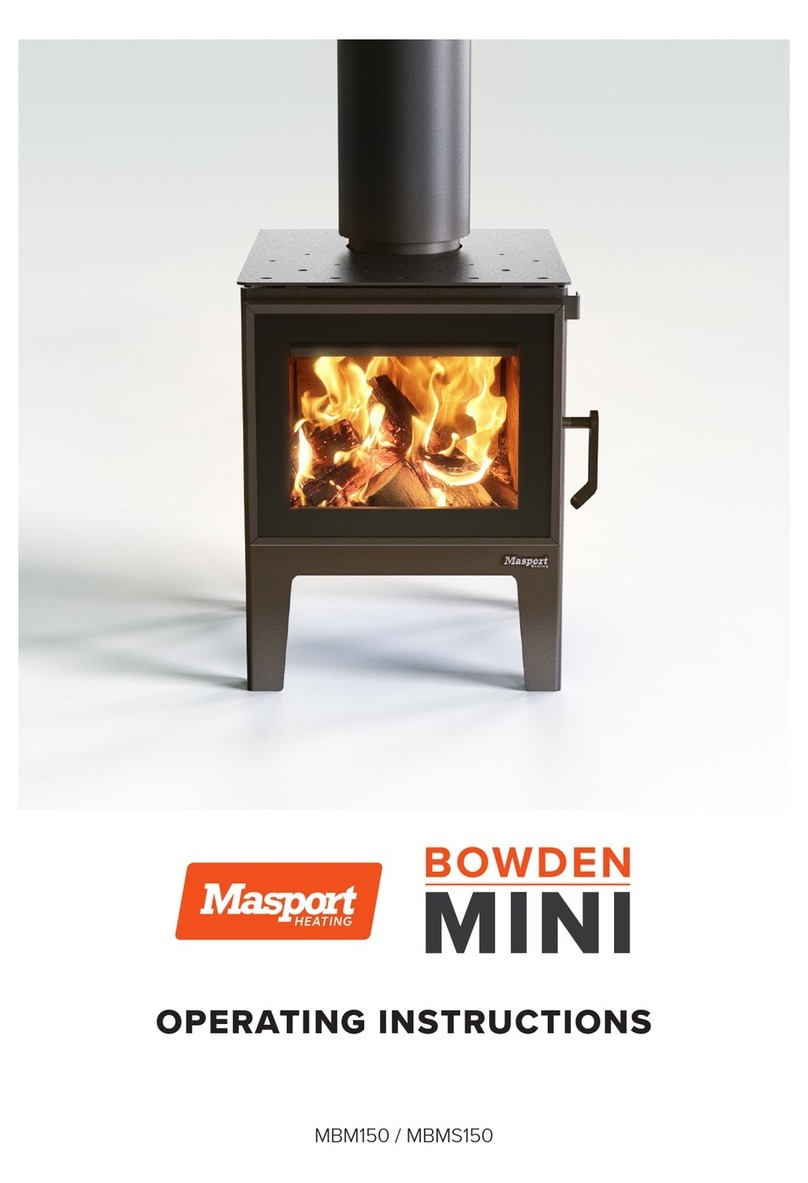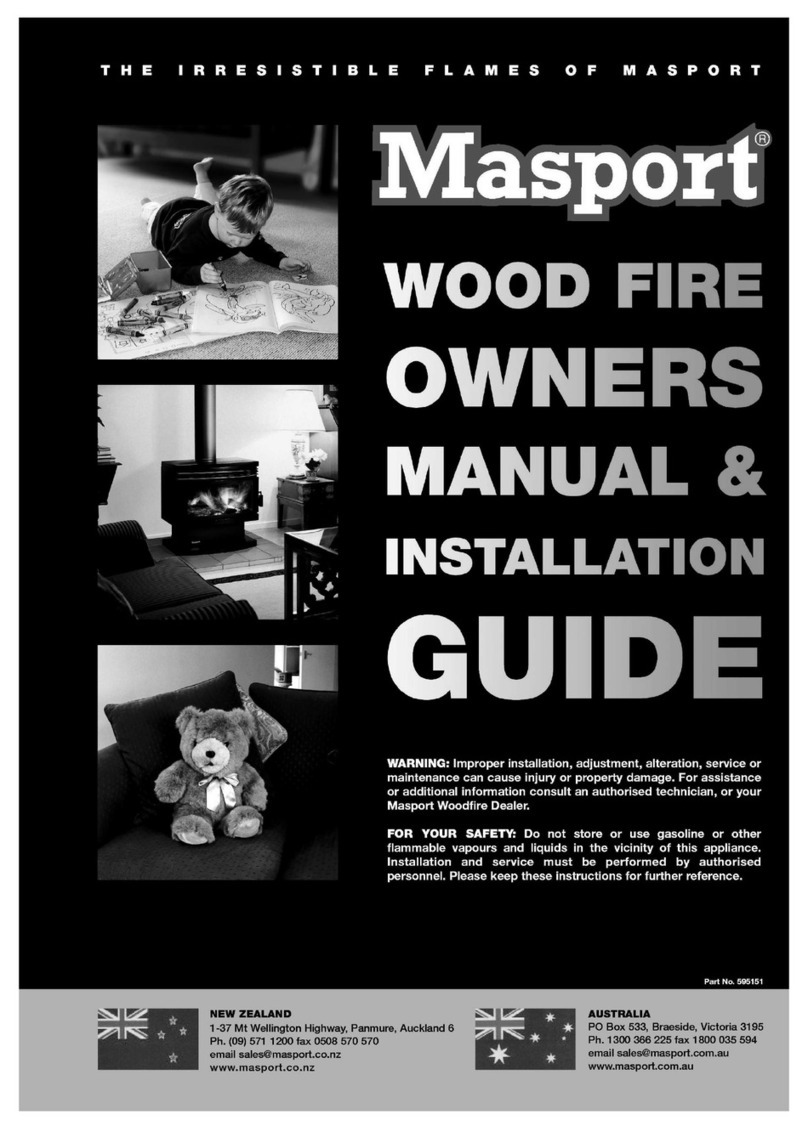Masport Bowden Portrait MBPT400 User manual

OPERATING INSTRUCTIONS

Glen Dimplex Australia proudly supports the activities of
Landcare Australia through its membership of the AHHA.
VERSION 1.0
MBPT400
(BOWDEN PORTRAIT)

1
TABLE OF CONTENTS
USER INSTRUCTIONS
1. Introduction.................................. 2
1.1. Air Controls ............................ 2
1.2. Door Handle ........................... 2
1.3. Wood Storage Compartment ............. 3
2. Using the Appliance for the First Time........... 3
3. Recommended Fuels ......................... 3
4. Lighting the Fire .............................. 3
5. Running the Appliance ........................ 3
5.1. Maximum Heat Output .................. 3
5.2. Low Heat Output ....................... 4
5.3. Reload with More Wood ................. 4
6. Burning Tips ................................. 4
6.1. Fuel Quality ............................ 4
6.2. Flue Draught ........................... 4
7. Ash Removal................................. 5
8. Flue/Chimney Fire ............................ 5
9. Cleaning Paintwork and Glass.................. 5
10. Cleaning the Flue............................. 5
11. Troubleshooting Tips.......................... 6
11.1. Glass in Door Blackening ................ 6
11.2. Trouble Starting the Fire ................. 6
11.3. Door Latch Misalignment ................ 6
11.4. Burning Too Quickly..................... 6
MAINTENANCE AND SERVICING
1. Replacement of Fire Bricks .................... 7
2. Replacement of Bae......................... 7
3. Removing the Door ........................... 8
4. Adjusting the Door Hinge...................... 8
5. Open door again and tighten screws fully. ....... 8
6. Adjusting the Door Latch ...................... 9
7. Fitting a New Door Seal ....................... 10
8. Fitting New Door Glass ........................ 10
9. Replacement Spare Parts List .................. 11
10. Warranty .................................... 12
10.1. Conditions ............................ 12

2
USER INSTRUCTIONS
1. INTRODUCTION
Before use of this appliance please read these
instructions fully.
WARNING: ANY MODIFICATION OF THE APPLIANCE
THAT HAS NOT BEEN APPROVED IN WRITING BY THE
TESTING AUTHORITY IS CONSIDERED AS BREACHING
AS/NZS 4013.
WARNING: DO NOT USE FLAMMABLE LIQUIDS OR
AEROSOLS TO START OR REKINDLE THE FIRE.
WARNING: DO NOT USE FLAMMABLE LIQUIDS OR
AEROSOLS IN THE VICINITY OF THIS APPLIANCE
WHEN IT IS OPERATING.
WARNING: DO NOT STORE FUEL WITHIN HEATER
INSTALLATION CLEARANCES.
WARNING: WHEN OPERATING THIS APPLIANCE AS AN
OPEN FIRE USE A FIRE SCREEN.
WARNING: OPEN AIR CONTROL BEFORE OPENING
DOOR.
WARNING: DO NOT BURN WOOD THAT IS PAINTED;
OR IS COATED WITH PLASTIC; OR HAS BEEN TREATED
WITH ANY CHEMICAL.
CAUTION: THIS APPLIANCE SHOULD NOT BE
OPERATED WITH CRACKED GLASS.
CAUTION: THIS APPLIANCE SHOULD BE MAINTAINED
AND OPERATED AT ALL TIMES IN ACCORDANCE WITH
THESE INSTRUCTIONS.
The appliance or flue system should not be modified in
any way without the written approval of the manufacturer.
Extraction fans or rangehoods must not be placed in the
same room or space, as this can cause appliance to emit
smoke into the room.
1.1. AIR CONTROLS
The Masport Bowden range of wood heaters feature
a single air control system. It is designed to introduce
oxygen into the base of the fire, controlling the rate of
combustion of the wood. In addition, oxygen is drawn into
the upper firebox where combustion of the gases occurs.
The air control is operated by sliding the black metal tab
located on the top right side of the heater. Pulled all the
way out oers maximum burn rate, while pushed all the
way in oers minimum burn rate. See below:
The air slide tab may become hot when fire has been
burning for some time.
Secondary air holes in the rear of the firebox provide
additional oxygen for a more complete combustion of the
gases released from the burning wood.
1.2. DOOR HANDLE
Warning: the door handle may get hot if appliance has
been left in high burn setting for an extended period of
time. Please exercise caution when operating.

3
1.3. WOOD STORAGE COMPARTMENT
Warning: the Masport Bowden Portrait features a storage
area for a small amount of firewood. Do not overload this
compartment - ensure that there is at least a 5mm gap to
the ceiling of the unit.
2. USING THE APPLIANCE FOR THE
FIRST TIME
The first few times the appliance is lit, it will give o some
odorous fumes. This is caused by the paint curing.
Do not touch the paint work while it is curing otherwise it
can leave a permanent mark on the appliance.
Once the paint has cured it will not re-occur.
Keep the room well ventilated until these fumes have
cleared.
3. RECOMMENDED FUELS
Burn only seasoned hardwood timber with a moisture
content of less than 20%. Newly cut wood should be
allowed to dry/season for 12 to 18 months before use.
Wood should be stored in an environment protected from
the weather to minimise any potential moisture content.
For best results, wood should not exceed 270mm in
length and 150mm in diameter. Any larger, and the
appliance will not operate at its optimum. It is better to
burn several smaller pieces of wood than one large single
piece.
Poor quality timber:
• Causes low combustion eciency
• Produces poor emissions (smoky)
• Results in additional buildup of creosote (soot) in
the flue which will then require regular cleaning
and may result in a flue fire.
Do not burn painted, impregnated/treated wood,
manufactured board products or pallet wood.
4. LIGHTING THE FIRE
1. Place firelighters or paper and dry kindling wood in
the base of the firebox.
2. Light the paper or firelighters.
3. Open the air control located on the top right of the
unit by pulling tab outwards.
4. If necessary, leave the door slightly open as the
fire establishes and the glass warms to avoid the
build-up of condensation.
5. Add larger pieces of wood. Too many logs may
smother the fire.
6. Close the door.
Do not leave fire unattended while the door is open.
5. RUNNING THE APPLIANCE
5.1. MAXIMUM HEAT OUTPUT
After establishing the fire and loading it with larger pieces
of wood, leave it running with the air slide fully open
(pulled all the way out).
This setting will generate maximum heat output.
Running the appliance with the door open will not
produce maximum heating in the room, as it will draw a lot
of already warmed air out of the room.
Do not overload firebox with fuel.
Note that this setting is not the most energy ecient as
some heat is lost up the flue instead of being transferred
into the room. However, once the fire is established,
particulate emissions will be very low in this setting.

4
5.2. LOW HEAT OUTPUT
The heat output of the appliance can be reduced by
closing the air slide which will restrict the oxygen supplied
to the fire and slow down the rate at which the wood
burns.
This setting provides the best energy eciency as the
wood burns for longer. However, if not operated correctly
it may worsen emissions.
Prior to closing the air slide, ensure that the fire is burning
briskly. This may require opening the air slide fully for
5-10mins before shutting down.
For the optimum between clean burning and getting the
best in eciency, from the fully closed position, open the
air slide 4-5mm.
The air slide can be adjusted to any position depending
on desired heat output versus burn time.
5.3. RELOAD WITH MORE WOOD
1. Open air slide before opening door.
2. Rake / break up any existing coals.
3. Load the wood with the length oriented front to
back.
4. Better results will be achieved by loading several
smaller pieces of wood rather than one large
piece.
5. Close door with air slide fully open, and leave for
a minimum of 10 minutes to allow the fresh wood
to catch.
6. After 10 or more minutes, the air slide can be
adjusted to the desired heat output setting.
6. BURNING TIPS
6.1. FUEL QUALITY
Use wood with a moisture content of less than 20%. Logs
should not feel moist or damp, or have moss and fungal
growths.
Symptoms related to wet wood:
• Diculty starting and keeping a fire burning well.
• Smoke and only small flames.
• Dirty glass and/or fire bricks.
• Rapid creosote build-up in the flue/chimney.
• Low heat output.
• Short burn times, and blue/grey smoke from the
flue/chimney outlet.
Run appliance at high heat output for a short period each
day to avoid large build-up of tars and creosote within the
appliance and flue.
6.2. FLUE DRAUGHT
The flue has two main functions:
1. To safely remove smoke, gases and fumes from
the appliance.
2. To provide a sucient amount of draught (suction)
in the appliance to ensure the fire keeps burning.
Draught is caused by the rising hot air in the flue when
the fire has been lit.
The position, height and size of the flue can aect the
performance of the flue draught. Refer to installation
guide for details on flue installation.
Factors aecting the flue draught include:
• Insucient flue height
• Trees or other buildings nearby causing turbulence
• High and gusty winds

5
• Outside temperature and weather conditions
• Blocked flue
For advice on the correction of persistent flue problems
consult your supplier/installer.
7. ASH REMOVAL
Depending on the type of wood burnt and frequency, the
ashes will need removing every 2 to 6 weeks.
Retaining a minimum of 10mm of ash helps protect the
base of the firebox, and can make it easier to start the fire
next time.
Excess ashes should be removed when necessary, placed
in a non-combustible container with a tightly fitting lid
and moved outdoors immediately to a location clear of
combustible materials.
8. FLUE/CHIMNEY FIRE
If a flue/chimney fire occurs:
• Shut air slide control fully to smother the fire
• Do not use the appliance after a flue fire until an
accredited installer has assessed the cause and
any resultant damage.
9. CLEANING PAINTWORK AND GLASS
The appliance, when cool, can be cleaned with a damp
cloth.
Over the years, the black paint will fade and can be
touched up with Stove Bright metallic black paint.
To clean the glass, we recommend using a household
window cleaner or general purpose cleaner with a soft
cloth. Do not use abrasive cleaner or scourer pads.
10. CLEANING THE FLUE
Check inside of flue prior to each season for any build-up
of creosote (wood tar). To do this:
1. First remove the bae (refer to “2. Replacement
of Bae Plate” under Maintenance & Servicing
section).
2. Using a small mirror and torch hold the mirror on
an angle below the flue with the torch shining
at it and look for black creosote build-up. A fine
black powdery layer is normal, but if built up layers
of creosote can be seen, then the flue needs
cleaning.
3. Refit the bae if no cleaning is required.
To clean the flue:
1. A flue cleaning brush can be purchased from most
wood heater retail outlets or large hardware stores.
2. The objective is to pull the brush down through
the flue.
3. With the bae removed, tie a rope to one end of
the brush, and drop the rope from the top (outside
on top of the roof) down the flue.
4. Grab the end of the rope inside the firebox and pull
the brush through.
5. Check the inside of the flue with the mirror and
torch. Repeat if necessary.
6. Once clean, remove any excess creosote from the
firebox and replace the bae.
Check flue integrity by checking that the 900mm flue
sections have not separated at the joins.
Alternatively, get a flue cleaning service to do the job for
you (it’s a dirty job).

6
11. TROUBLESHOOTING TIPS
11.1. GLASS IN DOOR BLACKENING
This can have several possible causes:
• Burning unseasoned wood — if the wood is too
wet, it will cause the glass to blacken.
• Appliance operated at low temperature — after an
overnight burn where the air slide control has been
fully closed, the glass may have blackened. When
the fire is re-stoked and burning on the high heat
setting, the blackened glass should self-clean.
• Problems with the flue — insucient flue draught
can cause the glass to blacken. If the flue is too
short, not properly insulated, or in a position
that results in a downdraught, then there will be
insucient flue draught. Contact the installer
should this happen.
11.2. TROUBLE STARTING THE FIRE
If all ash has been removed from the firebox, it can upset
the supply of air to the base of the fire. When cleaning out
the firebox, retaining some ash can make it easier to start
the fire next time.
11.3. DOOR LATCH MISALIGNMENT
Over time the door may drop slightly, which can result in
the door latch not operating smoothly. In the event that
this happens, refer to “4. Adjusting the Door Hinge” on
page 8
11.4. BURNING TOO QUICKLY
If you find that the heater is burning through wood too
quickly, it could be due to one or a combination of the
below factors:
1. Latch needs adjustment (refer to “5. Adjusting the
Door Latch” on page 9)
2. Door seal needs replacing (refer to “6. Fitting a
New Door Seal” on page 9)
3. Bae needs replacing (refer to “2. Replacement of
Bae Plate” on page 7)

7
MAINTENANCE AND SERVICING
1. REPLACEMENT OF FIRE BRICKS
The purpose of the firebricks in the appliance is to
increase thermal mass and to guarantee the longevity of
the steel firebox. Over time the firebricks may become
cracked and crumble away. If so, they should be replaced.
To replace the firebricks:
1. Move any ash away from the bricks.
2. Remove the brick retainers and the bricks.
3. Replace with new bricks, and refit the retainers
which hold the bricks in place.
2. REPLACEMENT OF BAFFLE
The 25mm thick vermiculite bae helps to retain heat in
the firebox by lengthening the path of the flames so that
they do not go straight up the flue.
Over time, the bae may begin to deteriorate a little due
to the excessive heat. This will not aect the way the fire
burns.
Eventually the bae may wear out (5+ years) and if so will
need to be replaced. To replace the bae:
1. Remove the front bae retainer.
2. Shift the bae to the right of the heater, lifting the
bae up on the right side.
3. With the right side of the bae raised above the
right bae rail, angle the left side of the bae
downwards to clear the left bae rail.
4. Remove bae from heater. Ensure rear retainer
is installed on new bae. Repeat steps 1 to 3 in
reverse to install new bae.
FRONT
BAFFLE
RETAINE
R
BAFFLE
RAILS
BAFFLE
REAR
BAFFLE
RET
AINER

8
3. REMOVING THE DOOR
To remove the door:
1. Open the door all the way.
2. Lift the door up and over the top end of the vertical
hinge rod.
3. Lower the door and slide o the bottom end of the
hinge rod.
4. ADJUSTING THE DOOR HINGE
Over time the screws securing the door hinge plate to
the heater may loosen resulting in the door dropping, i.e.
visually appears on slight angle and no longer perfectly
horizontal. This can result in poor latch feel, a loose door
seal and unnecessary amounts of oxygen entering the
firebox and wood burning too quickly.
To fix this and reposition the door:
1. With the supplied 5mm hex key, loosen the three
screws on the hinge plate.
2. With the door 90% closed, slowly lift the bottom
right corner of the door until the door is horizontal.
3. Keeping the door in that position relative to the
hinge, open it and tighten the screws until firm.
4. Close the door to 90% again and make any final
adjustments up or down by tapping the door on
the right hand side until it appears parallel relative
to the top and bottom surfaces of the heater.
5. Open door again and tighten screws fully.

9
6. ADJUSTING THE DOOR LATCH
Over time, the door seal can become compressed,
resulting in a less than adequate seal between the door
and the front edge of the firebox. For example, if the
wood burns unusually fast even with the air slide shut, it
may mean that there is an air leak around the door.
In this situation, the door seal does not necessarily need
replacing — adjustment of the latch can tighten the seal.
To adjust the door latch:
1. Using the supplied 5mm hex key, loosen the M8
barrel nut.
2. Using an adjustable wrench, loosen the M8 hex nut
holding the latch to the firebox.
3. Slide the latch inwards 1-2mm and retighten the
M8 hex nut.
4. Close the door and test the tightness of the latch.
If too tight or not tight enough, readjust until
adequate latching pressure is achieved.
5. Tighten M8 barrel nut when finished.
If the door is still not latching adequately – replace the
door seal.
LATCH BOLT
LATCH NUT
LATCH BUSHING
10MM OD
LATCH BUSHING
12.5MM OD BARREL NU
T

10
7. FITTING A NEW DOOR SEAL
This task may be easier with the door removed from the
appliance and laid horizontally on a work-bench.
1. Remove any old seal from the door.
2. Clean out the groove in the door that the seal
was bedded in using a flat-end screw driver or
equivalent.
3. Run a thin bead of clear roof and gutter silicone
along the groove.
4. Starting at one end, press the new door seal into
the groove on the door.
5. Refit the door if it has been removed and close.
APPLY
SILICONE
8. FITTING NEW DOOR GLASS
This task must be performed with the door removed from
the appliance and laid horizontally on a work-bench.
To replace the door glass:
1. Place the door glass side down on a work-bench.
Remove the 12x M6 nuts securing the glass
retainers.
2. Carefully turn the door over so the frame is resting
on the bench. Pulling the four glass retainers
outwards to remove.
3. Remove the door glass panel.
4. Observe the condition of the glass rope seal, if
deteriorated replace with supplied glass seal.
5. Fit the new glass onto the door frame, with the
painted border in contact with the glass rope seal.
FIBREGLASS
ROPE
6. Refit the glass retainers by repeating step 1 to 2 in
reverse.
7. Dispose of the old glass in a responsible manner.

11
9. REPLACEMENT SPARE PARTS LIST
PART DETAIL
Fire Bricks 4 @ 270 x 203 x 25mm
2 @ 270 x 100 x 25mm
Brick Retainers 3 X stainless brick retainer
straight, 2 X corner
Bae Plate Kit
365mm x 278mm x 25mm
vermiculite, matching front
and rear retainers
Door Seal 1720mm x 14mm round
Glass Seal 2100 x 19 x 3mm flat
adhesive backed
Door Glass 519.5 x 623.5 x 5mm Robax
Latch Bolt
(refer page 9) M8 x 35mm coach
Latch Bushing
(refer page 9)
10mm OD x 12mm
stainless
12.5mm OD x 26.5mm
stainless
Barrel Nut
(refer page 9) M8 X 15
Latch Nut
(refer page 9) M8 x 6.5mm hex
Door Handle M8 threaded
Door Handle
Hook 4mm plate
Door Handle
Nut M8 prevailing torque
Door Handle
Washer M8 spring

12
10. WARRANTY
Warranty is provided by Glen Dimplex Australia Pty Ltd.
This warranty is provided to the first domestic purchaser
of a Masport wood fire (radiant or convection). It applies
from the date of purchase from or through an authorized
Masport Fire Distributor in relation to each product or
component for the period below.
TYPE OF PART WARRANTY
IN YEARS
PARTS LABOUR
Wood Fire - Firebox 10 5
Door Glass & Seal 1 1
Fire Bricks & Retainer 1 1
Bae Components 1 1
During the warranty period, Glen Dimplex will repair
or replace (at its option) any Masport Wood Fire which
is found to be defective in materials or workmanship.
Repairs will be carried out by an approved Masport
Heating Service Agent.
What is covered under this warranty?
• Repair or replacement of parts
• Labour costs relating to the Wood Fire
• Reasonable transport or travel costs.
Consumers may have additional rights under the
Australian Trade Practices Act 1974 including the
Australian Consumer Law.
10.1. CONDITIONS
This warranty does not apply and will be void where:
• The Wood Fire is not installed in accordance with
AS/NZS2918:2018 or any building code or consent;
• The Wood Fire is not installed by a qualified
specialist installer;
• Any electrical work has not been carried out by a
Registered Electrician;
• The Wood Fire has been moved and reinstalled,
or has been modified in a manner that is not
consistent with the Installation Guide or the
Owner’s Manual;
• The Wood Fire has not been installed or operated
according to the Installation Guide and the
Owner’s Manual;
• The Wood Fire is acquired for business use in any
way.
What is not covered?
• Labour costs relating exclusively to components
not manufactured by Glen Dimplex.
• Damage caused by incorrect use or the burning of
treated or painted wood, driftwood or other fuels
which are not recommended.
• Travel costs for a distance greater than 50 km from
the nearest approved Masport Heating Service
Agent.
• Defects, malfunctions or failures caused by
incorrect installation, poor installation, normal
wear and tear, misuse, neglect, accidental damage
or failure to follow operating instructions in the
Owner’s Manual (including fuel selection, product
operation and maintenance instructions), repairs
or modifications by persons not authorised by
Glen Dimplex, use of parts not supplied by Glen
Dimplex, or damage or other events which have
occurred since the product left the control of Glen
Dimplex.
• Direct, indirect or consequential losses or special
damages of any kind (including costs of collection
and delivery) other than repair or replacement
of products or components under this warranty,
where any goods are acquired or used for the
purposes of a business;

13
How to obtain warranty service?
• Warranty Claims must be made at place of
purchase.
• Reasonable proof of purchase date is required
to make a warranty claim. You should keep your
purchase receipt.
• Warranty repair will be completed according to
normal work practices of the service agent.
• Make the faulty part(s) available to Glen Dimplex
for inspection so that the validity of the claim can
be established by them.

14
Glen Dimplex Australia Pty Ltd
8 Lakeview Drive,
Scoresby Victoria 3179
Australia
T: 1300 556 816 | F: 1800 058 900
General and Sales Enquiries: flame@glendimplex.com.au
Technical Service: service@glendimplex.com.au
www.glendimplex.com.au
Table of contents
Other Masport Wood Stove manuals
Popular Wood Stove manuals by other brands

RAIS
RAIS attika NEXO 100 GAS installation guide

WoodPro
WoodPro WS-TS-1500 owner's manual

Contura
Contura C 586W installation instructions

Palazzetti
Palazzetti EVA GENERAL INFORMATION - WARNINGS - INSTALLATION - MAINTENANCE

Lopi
Lopi 1250 Republic owner's manual

Panadero
Panadero CAPRI 3V Usage and maintenance instructions
